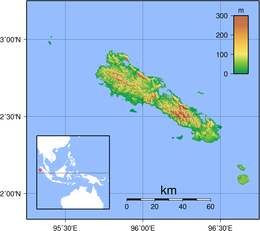 Topographic map of Simeulue Topographic map of Simeulue | |
| Geography | |
|---|---|
| Location | South East Asia |
| Coordinates | 02°37′48″N 96°05′24″E / 2.63000°N 96.09000°E / 2.63000; 96.09000 |
| Area | 1,754 km (677 sq mi) |
| Highest elevation | 567 m (1860 ft) |
| Highest point | unnamed |
| Administration | |
| Indonesia | |
| Province | Aceh |
| Regency | Simeulue Regency |
| Largest settlement | Sinabang |
| Demographics | |
| Population | 93,762 (mid 2021 estimate) |
| Pop. density | 51.0/km (132.1/sq mi) |

Simeulue /sɪməˈluːeɪ/ is an island of Indonesia, 150 kilometres (93 mi) off the west coast of Sumatra. It covers an area of 1,754 square kilometres (677 square miles), including minor offshore islands. It had a population of 80,674 at the 2010 census and 92,865 at the 2020 census. The official estimate as at mid 2021 was 93,762. Its capital is Sinabang.
Simeulue was once a part of West Aceh Regency but was split off in 1999 and became a separate Simeulue Regency.
Demographics
From the ethnic point of view the inhabitants of Simeulue are similar to the people of neighboring Nias Island. Two languages and a number of dialects are spoken on the island: Simeulue and Sigulai, which are different from the languages spoken in the north of Sumatra. The majority of the island's population is Muslim.
History
Simeulue was historically known to European mariners as "Hog Island" and served as a landfall for ships seeking ports on the west coast of Sumatra for the pepper trade. It was also known as "Pulo Oo", or "Coconut Island". Some historians suggest the fictional islands of Lilliput and Blefuscu in Gulliver's Travels (1726) might be described as two of Simeulue's remote islands in the Indian Ocean: Devayan and Sigulai.
2004 Indian Ocean earthquake
Simeulue was close to the epicenter of the 9.3 magnitude 26 December 2004 earthquake.
On 28 March 2005, an 8.7 magnitude earthquake struck with its epicenter just off the south end of the island. During the earthquake, Simeulue rose at least 2 metres (6 ft) on the western coast; this left the flat top of its coral reefs above high tide. On the east coast, the land was submerged, with seawater flooding fields and settlements.
Although Simeulue Island was only 60 kilometers from the epicenter of the 2004 earthquake, whereas Banda Aceh – the city that was hit hardest by the tsunami – was about 250 kilometers away, only six residents on Simeulue died, while the remaining 70,000 survived. This was apparently thanks to local wisdom called 'smong', which dictates that after an earthquake, if the tide suddenly recedes, people should evacuate to higher ground as soon as possible, based on the experience of a major tsunami in 1907.
Tourism
| This section does not cite any sources. Please help improve this section by adding citations to reliable sources. Unsourced material may be challenged and removed. (May 2024) (Learn how and when to remove this message) |
Over the past ten years Simeulue has become a popular surfing destination. The southwest-facing portion of the island is home to surf resorts.
See also
References
- Biro Pusat Statistik, Jakarta, 2011.
- Badan Pusat Statistik, Jakarta, 2021.
- Badan Pusat Statistik, Jakarta, 2021.
- BPS Kabupaten Simeulue (2003). Simeulue Dalam Angka 2012. BadanPusatStatistik.Com. ISBN 978-0-0100-0021-4.
- ^ JH Moor Notices of the Indian Archipelago (1837) (p103); retrieved 27 January 2019
- "Gibbons, Helen (April 2005) "Second Tsunami Causes Damage in Indonesia—USGS Scientists Post Observations on the World Wide Web" United States Geological Survey". Archived from the original on 2016-12-31. Retrieved 2014-11-08.
- Saved by tsunami folklore, BBC News From Our Correspondent, 10 March 2007
- Rahman, Alfi; Sakurai, Aiko; Munadi, Khairul (2018-08-01). "The analysis of the development of the Smong story on the 1907 and 2004 Indian Ocean tsunamis in strengthening the Simeulue island community's resilience". International Journal of Disaster Risk Reduction. 29: 13–23. doi:10.1016/j.ijdrr.2017.07.015. ISSN 2212-4209. S2CID 165012369.
- McAdoo, Brian G.; Dengler, Lori; Prasetya, Gegar; Titov, Vasily (June 2006). "Smong: How an Oral History Saved Thousands on Indonesia's Simeulue Island during the December 2004 and March 2005 Tsunamis". Earthquake Spectra. 22 (S3): 661–669. doi:10.1193/1.2204966. ISSN 8755-2930. S2CID 111256838.
- Suciani, A.; Islami, Z. R.; Zainal, S.; Sofiyan; Bukhari (2018). ""Smong" as local wisdom for disaster risk reduction". IOP Conference Series: Earth and Environmental Science. 148 (1): 012005. doi:10.1088/1755-1315/148/1/012005. ISSN 1755-1315.
- Pasotti, Jacopo (2014-12-10). "Smong: The Tsunami Story". Jacopo Pasotti. Retrieved 2018-07-29.
External links
 Media related to Simeulue at Wikimedia Commons
Media related to Simeulue at Wikimedia Commons